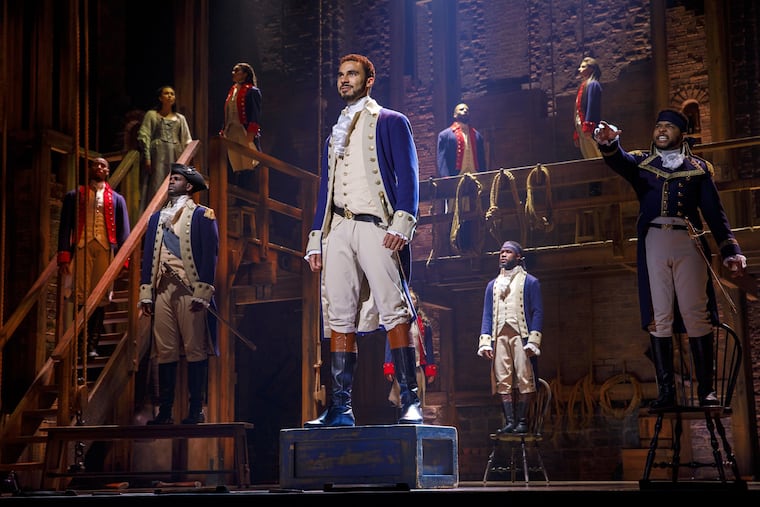‘Hamilton’ at Forrest Theatre: Philadelphia, it was worth the wait
A Philly audience at the venerable Forrest Theatre jumped to its feet to applaud Wednesday’s stellar, Broadway-comparable performance. There’s gorgeous singing, blazing dance, rapid rap, and a story that is literally for the ages.

One of the national tours of Hamilton finally, finally opened in Philadelphia this week, and it was worth the wait. A Philly audience at the venerable Forrest Theatre jumped to its feet to applaud Wednesday’s stellar, Broadway-comparable performance. There’s gorgeous singing, blazing dance, rapid rap, and a story that is literally for the ages.
There were fine individual turns, but the true stars are (1) a marvelously disciplined, hardworking ensemble, singing and dancing out the story (“We’re waiting in the wings for you,” they tell Hamilton), acting as chorus and organic, moving backdrop throughout; and (2) Lin-Manuel Miranda’s verbal flow, enlisting rap, slang, 18th-century formalities (“Mr. Burr, sir”), textbook history, and humor in lightning-paced oral athleticism. It teaches, it delights, it paints pictures and creates character. It enthralls.
It’s a New York-centric show, a paean to “the greatest city in the world,” but as Miranda himself has acknowledged, many of its most important events in the play happened in Philly, just blocks away from the Forrest itself. That includes Hamilton’s brilliant work as the nation’s first Secretary of the Treasury, and his climactic, ruinous 1791-1792 affair with Maria Reynolds, carried on largely at the Hamilton house at 79 S. Third Street. You’d never know that here.
But why complain? For three months Philadelphia has this wondrous show, played by a masterful, young, diverse cast with true passion. Many are the memorable actors. Josh Tower, who grew up in the Philly suburbs, makes Aaron Burr his own, as the ambitious, hapless “damn fool who shot him,” with a burr in his voice that helps us feel his anxiety. Philly’s Leslie Odom Jr., of course, owned the role on Broadway, but Tower is crustier, sweatier. He plays Burr as a loser.
Edred Utomi is good as Hamilton, a stalwart presence and capable dancer and singer. I wanted more electricity between him and other characters. A certain distance suits Hamilton as a man nobody really knows, but here there’s some inertia in the role. Utomi is convincing, however, near the end, as the older, chastened Hamilton. Bryson Bruce as both Lafayette and Jefferson is a physical dynamo. Daveed Diggs killed in this role on Broadway, but Bruce reached out and grabbed the audience with terrific dance moves, stunning, machine-gun delivery, and absolutely Satanic glee when Hamilton’s star begins to fall. His entry during “What’d I Miss?” was hilarious.
Elizabeth Schuyler, who becomes Hamilton’s wife, is sung in a pretty, flexible soprano by Hannah Cruz (through Sept. 15; on Sept. 17, Zoe Jensen takes over the role), evincing hope, kindness, and vulnerability, particularly in one of the show’s peaks, “Burn.” But the vocal standout is Stephanie Umoh as Eliza’s sister Angelica. In the Hamilton tradition, she has the more deep-bodied voice, as the person who comes closest to understanding Hamilton, whom she loves but can never have. Umoh is simply fantastic in this role, at once strong and sacrificial.
Peter Matthew Smith is a gut-busting King George, singing his retro pop tunes with a growl, teeth bared, scepter swinging. Paul Oakley Stovall is a George Washington with attitude. He worries about Hamilton even as he admits that “I need my right-hand man back.” “I trusted him,” he sings in “Alexander Hamilton,” and his through line traces the history of that trust. And his farewell in “One Last Time” brought one of the night’s biggest rounds of applause.
But maybe my favorite single turn is that of Jon Viktor Corpuz as Hamilton’s friend John Reynolds and later Hamilton’s son Philip. Corpuz plays Lawrence as a man of bright belief in the cause of Revolution. As Philip, he is the son ready to die to make his father proud. Corpuz brings a very touching gender indeterminacy to both roles, showing us the gentleness in the soldier, the tragic, lovable impetuousness of the son.
The Forrest is a space well suited to this onrushing show, easily embracing the tsunami of sound. The celebrated stage design by David Korins is lovingly reproduced, with folding stairways, ropes, pulleys, a double turntable, and second-level catwalk that vividly represent so many times and places. Howell Binkley’s lighting design struck me, especially at the moment King George sings, “I’m so blue,” stamps the floor, and a blue spot hits him.
But back to the two real stars: the ensemble and the language. The person next to me, a Hamilton newbie, called the show “dense,” in the sheer amount of stuff coming at you at once. He also marveled at the uncanny pacing and dynamics of this show, modulating the tempo so it’s never too much. The ensemble, ever in motion, helps Hamilton and Burr and the sister tell their stories. When Angelica arrives from England to help Eliza, the ensemble cries as one, “Angelica all the way from London! Damn!” And as Hamilton begins to give in to Reynolds, the ensemble cries, “No! No! Say no to this!” They stand for our emotions; they say what the characters know but can’t say, driving home the ironies. For me the Battle of Yorktown is the utter highlight, danced breakdance-style, as the ensemble sings, “Yorktown (The World Turned Upside Down).” Seldom has there been a more definitive turning point, in war or theater.
As for the language, it’s so well-known now, sung in schoolyards throughout the land, that I’ll just say: Go see Hamilton.
ON STAGE
Hamilton
Through Nov. 17 at the Forrest Theatre, 1114 Walnut St.
Tickets: $127-$197, with a select number of $497 premium seats. Forty tickets will be sold for each performance, on a rolling basis, for $10 each through a digital lottery system.
Information: Kimmelcenter.org, 800-447-7400.